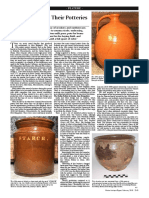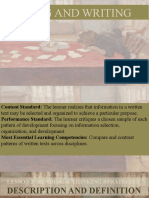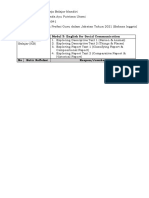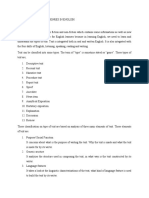Descriptive Texts
Uploaded by
messi22argentinaDescriptive Texts
Uploaded by
messi22argentinaDESCRIPTIVE TEXTS
Descriptive text is a type of text that describes or explains a person, place, or thing in detail. The purpose
of descriptive text is to provide a clear picture of the characteristics or attributes of the subject being
described.
Here are some characteristics of descriptive text:
Uses attribute verbs, such as be (am, is, are)
Uses easy tense
Focuses on a single object
Uses principle nouns, such as my cat, my swain, or monument
Uses adjectives to clarify the use of nouns, such as a giant house or a sensible student
Uses basic verbs or first form (verb 1)
Some examples of objects that can be described in a descriptive text include: Animals, Places, People,
Food, and Things.
Descriptive texts often contain describing words to help build up an image in the reader's mind. They
may draw upon your five senses (seeing, hearing, feeling, smelling and tasting) to help you to imagine
what something is like. For example: The white sandy beach stretched around the gently curving cove.
Britannica Dictionary definition of DESCRIPTIVE. 1. [more descriptive; most descriptive] : giving
information about how something or someone looks, sounds, etc. : using words to describe what
something or someone is like. She gave a descriptive account of the journey.
Descriptive research design is a powerful tool used by scientists and researchers to gather information
about a particular group or phenomenon. This type of research provides a detailed and accurate picture
of the characteristics and behaviors of a particular population or subject.
Description is a statement or account giving the characteristics of someone or something: a descriptive
statement or account. The review was little more than a description of the film's plot. 2: kind or
character especially as determined by salient (see salient entry 1 sense 3b) features. someone fitting the
suspect's.
Descriptive use refers to the manner in which a trademark is employed in a way that describes the
goods or services rather than indicating their source.
Description is any type of communication that aims to make vivid a place, object, person, group, or
other physical entity. Description is one of four rhetorical modes (also known as modes of discourse),
along with exposition, argumentation, and narration.
The primary purpose of descriptive writing is to describe a person, place or thing in such a way that a
picture is formed in the reader's mind. Capturing an event through descriptive writing involves paying
close attention to the details by using all of your five senses.
You might also like
- Refutation of - Some Observations, - by Frithjof Schuon - Criticizing René Guénon - Pages 16 To The End.No ratings yetRefutation of - Some Observations, - by Frithjof Schuon - Criticizing René Guénon - Pages 16 To The End.42 pages
- The Dodges and Their Potteries - Maine Antique Digest February 2018100% (1)The Dodges and Their Potteries - Maine Antique Digest February 20183 pages
- Makalah Descriptive Text - Kelompok 4 Bahasa InggrisNo ratings yetMakalah Descriptive Text - Kelompok 4 Bahasa Inggris12 pages
- Teks Descriptive (Descriptive Text) : PengertianNo ratings yetTeks Descriptive (Descriptive Text) : Pengertian2 pages
- Summary Modul 3: Descriptive Text Is A MeaningfulNo ratings yetSummary Modul 3: Descriptive Text Is A Meaningful2 pages
- Cream Brown Illustrative Group Project Presentation - 20240829 - 111544 - 0000No ratings yetCream Brown Illustrative Group Project Presentation - 20240829 - 111544 - 000011 pages
- 3 Ways of Elucidating Concept - English12No ratings yet3 Ways of Elucidating Concept - English1219 pages
- The Rhetorical Modes: Writing in The DisciplineNo ratings yetThe Rhetorical Modes: Writing in The Discipline22 pages
- Makalah: "The Structure of English Text"No ratings yetMakalah: "The Structure of English Text"6 pages
- Lesson: Patterns of Development in WritingNo ratings yetLesson: Patterns of Development in Writing9 pages
- Reading and Writing Skills MODULE WEEK 1No ratings yetReading and Writing Skills MODULE WEEK 112 pages
- Creative Writing - Quarter 1 - LAS - ContinuationNo ratings yetCreative Writing - Quarter 1 - LAS - Continuation24 pages
- Presentasi (dibuat dari Doc Anda)_20241203_194356_0000No ratings yetPresentasi (dibuat dari Doc Anda)_20241203_194356_00009 pages
- Hijau Krem Kuning Ceria Tugas PresentasiNo ratings yetHijau Krem Kuning Ceria Tugas Presentasi8 pages
- Standard Solutions: Innovative Fluid PowerNo ratings yetStandard Solutions: Innovative Fluid Power70 pages
- On The Use Non-Stationary Penalty Functions T o Solve Nonlinear Constrained Optimization Problems With GA'sNo ratings yetOn The Use Non-Stationary Penalty Functions T o Solve Nonlinear Constrained Optimization Problems With GA's6 pages
- Sequence Diagram Tutorial - Complete Guide With Examples - Creately Blog100% (1)Sequence Diagram Tutorial - Complete Guide With Examples - Creately Blog16 pages
- H.K. Moffatt - Cosmic Dynamos: From Alpha To OmegaNo ratings yetH.K. Moffatt - Cosmic Dynamos: From Alpha To Omega5 pages
- Customs and Traditions Listening While Watching100% (2)Customs and Traditions Listening While Watching4 pages
- 215 Cultural Safety Module and Self-Evaluation Assignment 2021 1No ratings yet215 Cultural Safety Module and Self-Evaluation Assignment 2021 115 pages
- Technica Notes: Reaction of Aluminum With Sodium Hydroxide Solution As A Source of Hydrogen100% (2)Technica Notes: Reaction of Aluminum With Sodium Hydroxide Solution As A Source of Hydrogen3 pages
- Engineering Resume For Internship Example TemplateNo ratings yetEngineering Resume For Internship Example Template2 pages
- Badri Engineering Corporation: One Stop Shop For All Your Industrial NeedsNo ratings yetBadri Engineering Corporation: One Stop Shop For All Your Industrial Needs2 pages

























































































